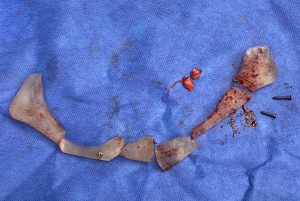Despite the tremendous benefits of a custom jawline implant there is always the need for revision of it. Whether due to its size, design or placement the potential need (risk) of revisional surgery always exists. In fact that risk is higher for custom implants than standard implants which can be very confusing to patients.
What a custom jawline implant means is that you can make an implant design anyway you want and that it is made based on the patient’s specific bony anatomy. But that does not mean it will have guaranteed perfect placement on the bone nor will not necessarily create the exact external aesthetic result that the patient desires. The former requires human placement of a large implant through small incisions where the exact placement of the implant on the bone is not completely visible. For the latter the implant design is a best guess estimate of the dimensions needed to approximate the patient’s preoperative picture imaging goals.
As a result it is not rare that a custom jawline implant needs to be adjusted, replaced with a different implant design or even rarely completely removed and not replaced. It is at this point that how easily or difficult the implant is to mobilize or remove comes into play.
While the material composition plays an important role in the implant removal process it is also affected by how it is secured. (i.e., how many screws and what type of screws) While solid silicone jawline implant provides the easiest placement and subsequent removal if needed, excess screw fixation can pose its own problems.

This is a great example of, while some screw fixation has its role in initial implant placement security, more screws are not necessarily better. Beyond a certain number such screws do not have benefit and can make any subsequent surgery more difficult than it needs to be. This is not a fracture that needs to heal, the implant merely needs to be held in place until the encapsulation process has occurred. Once this happens the screws are not necessary and may even become a liability later.
Dr. Barry Eppley
World-Renowned Plastic Surgeon



